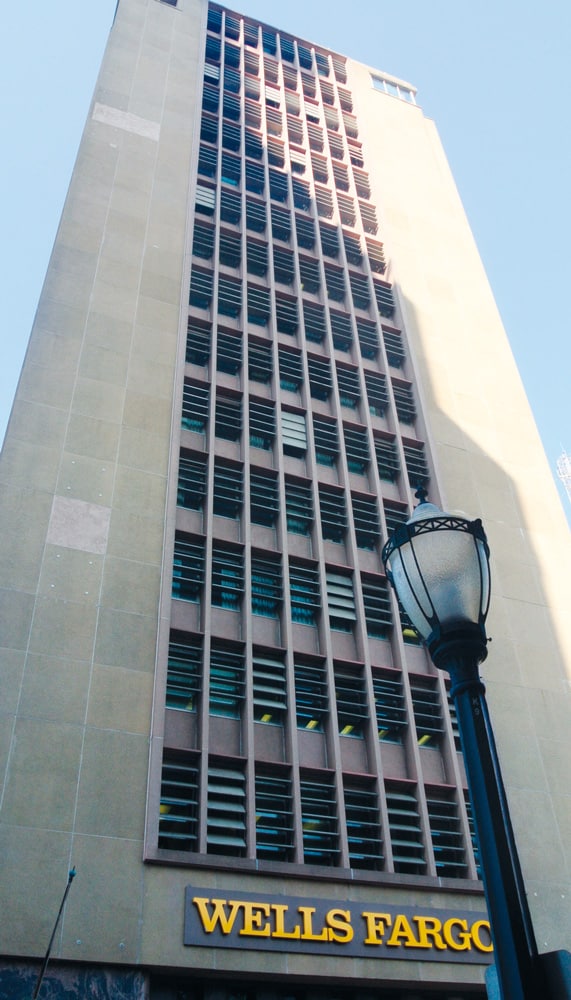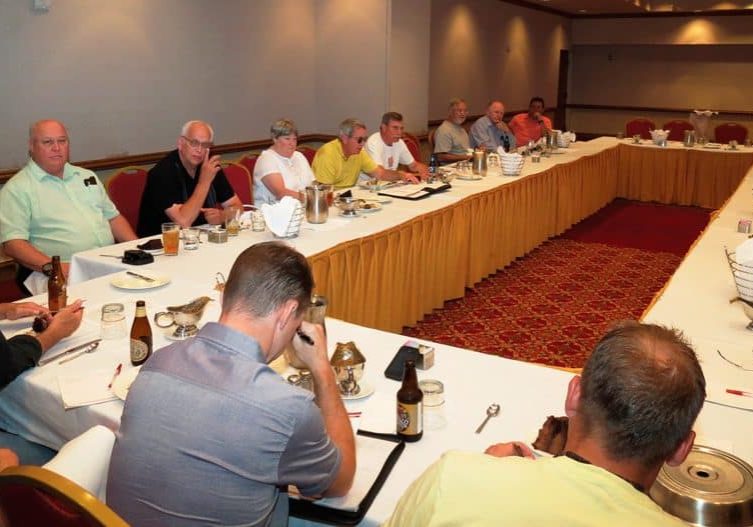Inside the 16-story Wells Fargo office building (often called by its original name — the Waterman building) in downtown Mobile, Alabama, one finds elevator equipment dating from the mid 1940s, when the Waterman was built, to today. That is due to a recent historic renovation performed by KONE to enhance comfort, safety and performance for those who use the four-unit system. With its large, bright machine room and cabs that provide a smooth, fast ride, the system brings pleasure to elevator mechanics and building tenants alike. Before, the building had an uncomfortably hot, dim machine room for mechanics and slow, wobbly elevator rides for tenants. Standing in the 35- X 20-ft. machine room, Michael Dupree, retired sales manager for KONE, recalls:
“When we first came up here, there were old incandescent light bulbs hanging from the ceiling, and it was hot — well over 100° F in the summer. It was really like coming into a dungeon. Now, we’ve got air-conditioning and modern lights, and it’s a whole different world.”
It is also a different world for tenants, who were thrilled to see the old system revitalized. Besides anchor tenant Wells-Fargo, there are importer-exporters, law offices and architects in the building. Dupree said once the first new unit was up and running, employees would stand in line to take it, rather than wait for one of the older elevators. It was a vastly more pleasant experience, he said, and often got them to their destinations faster than an old unit. Attorney Douglas Brown, a top-floor tenant, observes, “It’s so nice to be in this historic, Art Deco building but have 21st-century transportation.”
Waterman Steamship Corp. was built on the twin pillars of Mobile’s economy of the day — shipbuilding and shipping — and the downtown tower that served as its headquarters during its heyday in the 1940s-1950s also marked a turning point for Mobile Elevator & Equipment Co., the family business of which Elevator World, Inc. founder William C. Sturgeon was a part. In the mid 1940s, Mobile Elevator found itself in competition with Otis to install Waterman’s elevator system. Mobile Elevator, a David to Otis’ Goliath, ended up winning the bid. In his autobiography, More Ups Than Downs, A Memoir, Sturgeon describes the job as both thrilling and scary, and noted that, in the end, it offered valuable lessons that helped him make better business decisions.
Considered a skyscraper when and where it was built, the building has a blonde and brown brick façade and, at the time of its construction, stood out for its stark, modern look. The interior is lush, with features such as marble walls in the elevator lobby and elsewhere. Its two-story main lobby is its showpiece. It has a domed ceiling painted with frescoes by Louisiana artist Conrad Frabrizio depicting maritime commerce and the elements of land, water, fire and air. An intricately painted, multicolored Rand McNally globe 12 ft. in diameter, surrounded by an impressive brass rail, was displayed in the lobby until 1973, when it was placed in storage. The globe was a popular attraction for tourists and students. At one point, two attendants conducted tours of the building and globe.
A lot has changed since then. The globe was reconstructed by the University of South Alabama in 1996 and it is now on display at its Mobile campus. The end of World War II brought a decline in demand for vessels and a consequent drop in business for Waterman, which was purchased in the mid 1950s by a shipping rival.
Changes were in store for Sturgeon, as well. As the 1950s began to unfold, the businessman and war veteran saw the need for an industry trade publication and launched ELEVATOR WORLD in 1953. Mobile Elevator was sold to Montgomery Elevator in 1963. Montgomery was later acquired by KONE.
The Waterman’s name was changed when it was bought by the rival, which sold it to a bank in 1973. That brought about another name change — a trend that has continued over the past decade as U.S. banks consolidated. It has sported a Wells Fargo sign since Wells Fargo acquired Wachovia in 2009. Wells Fargo employees conduct business in the lobby, and have, arguably, one of the best work environments in the city.
Now, they and their fellow tenants have a state-of-the-art elevator system, as well. The finishing touch, renovation of the cab interiors, was completed earlier this year by property manager John Toomey & Co.
Dupree notes that from top to bottom, the system exhibits “a world of difference.” But not everything is different: The four original General Electric gearless traction machines installed in the 1940s are still chugging away. “According to the man who tested them, these machines are some of the best ever built,” Dupree said. They have had a relatively easy life, like a Clydesdale pulling an empty wagon. Dupree explains:
“You can see how smooth and quiet these big, old machines are. Some machines [make] hundreds and hundreds of rotations per minute to get the same thing done. These machines were actually designed for a 100-story building, and here you’ve got them handling less than a fifth of that. They are just loping along.”
Each unit has a capacity of 1361 kg, or approximately 18 people. Montgomery Elevator control cabinets from 1957 housing blackened power switches have given way to new, more compact KONE cabinets with master control systems, and KONE drives, controllers and wire ropes allow the units to properly handle acceleration, deceleration and leveling. That allows them to comfortably run at their full speed of 700 fpm. Prior to renovation, the slowest unit ran at approximately 375 fpm and the fastest at 500 fpm. “It felt like a freight train before,” KONE elevator mechanic Larry Bourgeois observed.
Dupree says he misses some of the system’s original components, such as brass and nickel directional lanterns and indicators (which have found a new home on your reporter’s office window sill). They have been replaced by modern, digital components. Instead of wood-grain Formica®, cab interiors now feature scalloped, gold walls and hammered-tin ceilings. The ceilings’ corners remain curved, however, and vestiges of the past — such as round, decorative Formica ceiling accents, remain as well.
Other new features include those relating to safety and energy efficiency. Keyways allow mechanics to open hoistway doors from any floor in case of an emergency. Dupree said prior to the renovation, “a power outage affected this whole building, and a pregnant lady got stuck on one of these elevators. Mechanics had to use a broom or mop to get up through the hoistway and unlock the next door and go up until they could get up there to where she was — there was no other way to get in the doors.” Fortunately, the woman was rescued and suffered no ill effects. A Hollister-Whitney Rope GripperTM ascending brake, meanwhile, prevents elevators from “falling” up — a scenario Dupree noted is much more common than a plunge.
The new system generates power back into the building and is compliant with ASME 17.3 and Americans with Disabilities Act requirements. It is, Dupree notes, more than ideal. “We’re over-elevatored right now,” he says.
Get more of Elevator World. Sign up for our free e-newsletter.










